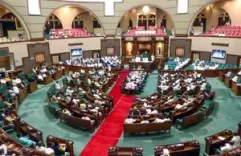UN Analysis Estimates India's GDP Growth at 6.6% for 2025, While China Expected to Slow to 4.8%

New Delhi, Jan 9 (NationPress) India’s economy is projected to expand by 6.6 percent in 2025, following an estimated growth of 6.9 percent in 2024, primarily driven by private consumption and investment, as reported in the UN World Economic Situation and Prospects (WESP) 2025 report published on Thursday.
Moreover, India’s robust export growth in services and select manufactured goods is expected to enhance economic activity, as stated in the UN's flagship economic report.
Conversely, the report indicates that the Chinese economy is likely to experience a continued trend of gradual moderation due to subdued household consumption, ongoing weaknesses in the property sector, and escalating trade tensions. Growth for China is anticipated to be 4.8 percent in 2025, compared to an estimated 4.9 percent in 2024.
The UN report forecasts that global growth will hold steady at 2.8 percent in 2025, remaining unchanged from 2024. Although the global economy has shown resilience in the face of multiple shocks, growth is still below the pre-pandemic average of 3.2 percent, hampered by weak investment, sluggish productivity growth, and high debt levels.
The report highlights that lower inflation and ongoing monetary easing in various economies could offer a slight boost to global economic activity in 2025. Nevertheless, significant uncertainty persists, with risks arising from geopolitical conflicts, rising trade tensions, and elevated borrowing costs in various regions of the world. These challenges are particularly pronounced for low-income and vulnerable nations, where subpar and fragile growth threatens to hinder progress towards the Sustainable Development Goals (SDGs).
“Countries cannot overlook these dangers. In our interconnected economy, shocks on one side of the globe impact prices on the other. Every nation is influenced and must contribute to the solution - building on the progress achieved,” stated United Nations Secretary-General Antonio Guterres in the report's foreword. “We’ve charted a course. Now it’s time to act. Together, let’s make 2025 the year we set the world on a path toward a prosperous and sustainable future for all.”
The UN report also notes that East and South Asia face increasing downside risks that could hinder economic prospects. Key risks and challenges include rising geopolitical tensions, trade disputes, and the impacts of climate change, which could reignite inflationary pressures and pose severe threats to food security. Additionally, prolonged weaknesses in China’s property market and high levels of public and external debt across numerous South Asian nations could further destabilize economic conditions.
In light of these risks and challenges, governments throughout East and South Asia have adopted tailored policies. Easing inflation has led many central banks in the region to reduce interest rates in 2024. However, some monetary authorities remain cautious due to country-specific issues such as volatile food prices and high debt levels.
On the fiscal side, regional countries are focusing on regaining fiscal space and bolstering economic activity through strategic public spending and reforms, as the report highlights.









